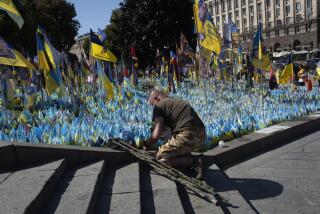More Vivid Memories of Liberation
Two letters to The Times (Feb. 2 and 23) brought back vivid memories of the liberation of the Philippines 40 years ago, and prompt me to share our dramatic rescue.
Interned as a teen-ager, along with a younger brother and sister, plus our parents, we were under the control of the Japanese for more than three years. The final months of the occupation found us in the Los Banos Internment Camp, 50 miles south of Manila. As the American forces moved into the capital city, they liberated the civilians in Santo Tomas, but it was not until three weeks later that the 2,146 of us in the Los Banos camp were freed.
At dawn on the morning of Feb. 23, just as we were about to line up for morning call, we heard the roar of U.S. planes flying low. Suddenly, 150 paratroopers dropped from the C-47s at the dangerously low altitude of only 400 feet. The airdrop was the signal for the Filipino guerrillas to burst into the camp and overpower the Japanese guards and the enemy garrison nearby. The fighting lasted for less than an hour.
Rushing around to welcome our U.S. rescuers, we were ordered to leave our barracks at once, taking nothing but a few personal items. We went. As each barracks was emptied it was set afire by our own soldiers. We walked down the road as a family, rejoicing as we joined many friends in the pathways between burning barracks of bamboo and thatch. At the edge of the camp we noted tractor-tanks arriving and were ordered into them. We climbed in, managing to stay together as a family in the crush of the happy crowd.
Immediately the tanks took off, taking us down the main highway, past the railroad station and right out into the lake itself! When we reached the beach, we kept right on going, for we were in amphibious tractors, or “alligators.” The Japanese on shore fired at us, while the machine guns on each “alligator” answered their fire, as our planes flew low over us, protecting us.
That was our rescue. Unable to get through the Japanese lines, our forces had gone around them on the lake, picked up 2,200 internees and carried them across an arm of the lake to safety. The daring efforts of the 11th Airborne had brought to culmination a master plan that involved different branches of the military, resulting in an amazing, dramatic rescue, which Gen. Douglas MacArthur himself termed “The Miracle of Los Banos.” To my knowledge, not a single American life was lost that day, either civilian or military, although there were a few injuries.
The 52 amphibious tractors transported half of the internees in the first trip across Lake Laguna de Bay and then returned to pick up the remaining 1,000 civilians. At the end of the journey we found freedom and food. Our rehabilitation and relocation center was housed in the New Bilibid Prison at Muntinglupa, where we recuperated for six weeks before we were in fit physical condition for the long voyage home by troop transport.
During the past 40 years, we have managed to keep in touch with some of the paratroopers who jumped to rescue us that marvelous day, as well as some of the men who were on our particular amphibious tractor that made it to safety across the lake. We can never ever adequately express our gratitude to those who risked their lives in order to rescue us from our Japanese captors, but it is good to enjoy periodic reunions with these men.
Although my parents lived to see freedom, they did not have the opportunity to enjoy it for many years, as both of them died in Manila while still in their 50s. I have returned twice to the Philippines, and of course to Los Banos, to recall with thanksgiving that spectacular military achievement, and to express the prayer and hope that the peoples of this world will learn to live together in peace and harmony, where there is freedom for all, and where no one ever need be afraid to speak out for social justice.
R. THOMAS BOUSMAN
Santa Paula
I am writing in regard to the recent letters regarding the internees of World War II, alumni of “S.T.I.C.”--Santo Tomas Internment Camp, Manila. My stepfather, Paul R. Danner, was the happy recipient of the sunglasses case, described in two of your letters, that contained the message, “Roll out the barrel, etc.” My husband, Robert Gurney, my mother, Ruth Danner, my daughter, Melissa Gurney Porter, were residents of said university for three years for three months we were interned in the Ynchausti house, a private residence where members of the high commissioner’s staff were interrogated.
Toward the end of our internment I remember one glorious day when I looked heavenward and saw our Navy planes flying overhead! That was the beginning of our freedom! I, too, remember the “Georgia Peach” crashing through the gates; the wonderful men who sacrificed their lives to rescue us, the tenderness and compassion of those who entered our camp sharing their rations with us.
My mother awakened in her hospital bed from a coma, seeing an American soldier sitting on the edge of her bed remarked, “Are there any boys from New Jersey?” “No, Ma’am, he said. “It’s just too tough for those New Jersey boys!” They were all beautiful men, and I, too, want to thank them for saving our lives!
It was ironic though, that having weathered more than three years of internment many internees were brutally killed in the last two weeks of our incarceration. I remember sitting in the corner of the main building during the shelling, my small daughter cradled in my arms, watching the wounded and the dying, especially a young widowed mother who was mortally wounded. Her one twin son was with her when she died; they could not find the other one in time. It will be forever etched in my mind.
I remember Gen. MacArthur’s arrival, standing on the steps of the main building greeting all of his old Manila friends.
No one knows how fortunate they are to be living in a country such as this--with its glorious heritage. When you have that freedom that is taken so much for granted taken away from you, when it is returned it gives you a deeper appreciation of its goodness.
You cannot comprehend one’s feelings upon seeing our flag raised again, flying so proudly. It is a symbol of hope, courage, and most of all, freedom!
GRATIAN GURNEY
Glendora


